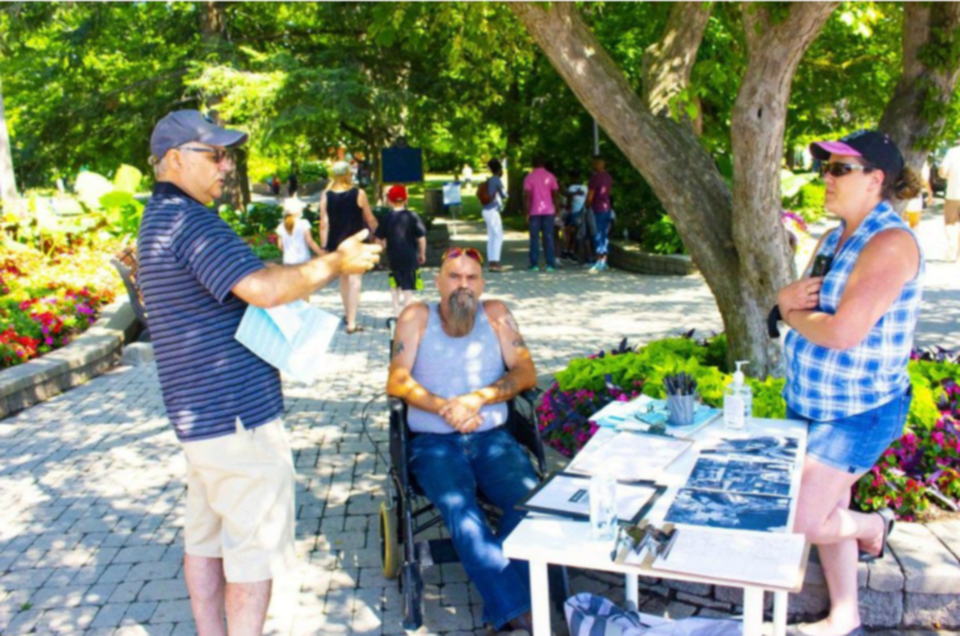A petition supporting horse-drawn carriages has garnered more than 2,800 signatures since it was launched on July 6 with international support coming from England and Ireland.
Organizers Kimberley Hall and Richard Henderson say the carriage business protects horses by saving them from slaughterhouses.
The petition was started in direct response to anti-carriage protesters who have frequented NOTL for more than three years.
“We just want council to know that (the protesters’) isn’t the only opinion, that there is an opinion by people who enjoy carriages and even like them,” Hall told The Lake Report.
Sam Addario, of the group Ban Horse-drawn Carriages, wants the practice to end.
“Our position is that it’s cruel and exploitative to put horses in traffic. It’s a position that’s dangerous and uncomfortable for them.”
“They suffer tremendously wearing all that gear and being in the heat. Being prey animals in a dangerous, fast-paced environment makes them suffer. We don’t think it’s fair to exploit animals in traffic and make them work against their will.”
Hailey Beattie, 17, who works for Sentineal Horse Carriages, noted their horse Ethan weighs over 2,000 pounds "and can pull three-times that weight."
"If he didn’t want to do something, he wouldn’t. He would tell us, he would show us, we understand how to read horses,” she said.
One of the anti-carriage protesters' suggestions to keep carriage operators in business is a switch to electric carriages.
“We have the technology. We don’t have to be doing this. There’s a reason we don’t ride horses any more for transportation,” Addario said.
Queen’s Royal Carriage owner Jeff Sentineal has previously suggested his company is open to transitioning to electric carriages, a stance the protesters were eager to mention.
But Henderson wants the people who would see horse carriages taken off NOTL’s streets to consider where the horses would be without the industry.
“Their horses are rescued,” he said.
“They rescue them from the slaughterhouses and protect them and let them have that life that they deserve.”
Sentineal Carriages staff said that is the reality for work horses.
“We get a lot of our horses out of slaughterhouses and meat auctions,” said Sentineal driver Jade McLachlan.
“A lot of them are old Amish work horses and they just can’t pull a plow like they used to. It’s harder for the horses to do that work than it is for them to pull a carriage.”
She was standing beside Ethan, an old show horse who didn’t quite fit in with the rest of the animals.
“Clydesdales have a bit of a higher fancier step and he just didn’t have that,” she said. “He could have ended up in a meat auction.”
Unlike other industries, the carriage company doesn’t send its horses to meat auctions when they are too old to keep working.
The oldest horse that owner Fred Sentineal had was 42 when they ended up having to put him down, she said. "But he lived out a great retirement with us.”
McLachlan said the horses like to work, having been bred by humans for various jobs for thousands of years.
“We had an old guy named Duke. We tried to retire him two years in a row,” she said.
“Every time summer picked up and we started to get our carriages out he would actually break down the fence and go and stand by the trailer because he wanted to go back to work.”
She also stressed that the horses are well taken care of.
“They get their yearly shots, they get their fecal matter checked to make sure they don’t have worms and they have a full body check over.”
The horses even have customized diets to make sure they are getting the specific nutrients they need, she said.
Hall said she and Henderson started the petition on change.org to represent the people who support horse-drawn carriages and not to change people's minds about the issue.
“If somebody says they don’t want to sign we say, ‘Thank you very much and have a nice day.’ We don’t want to influence anybody.”
Another petition to ban all horse-drawn carriages in the Niagara region had more than 19,000 as of Monday.
A petition more localized to NOTL entitled “Pledge not to visit Niagara-on-the-Lake until horse-drawn carriages are banned” has gained 1,280 signatures in three years.
Henderson and Hall said the 2020 death of animal rights activist Regan Russell while protesting in Burlington prompted them to get involved in the NOTL debate.
“We saw the dangerous acts that the protesters were doing at Fearman’s and then we saw the, for lack of a better word, propaganda they were posting online about how safe their protests were and that led us to noticing what was happening down here,” Hall said.
Russell was hit by a transport truck during a protest outside a Fearman’s Pork Inc. slaughterhouse.
Some visitors seem divided on the issue.
“I’ve never taken a ride on them because I actually think it’s very cruel,” Stoney Creek resident Rose Murdoch said while visiting NOTL with her husband.
“We support animals. Do these horses even get water to drink?”
Bolton resident Pat D’Alessandro took the opposite view.
“This horse here was going to be slaughtered so I don’t have any problem with this,” he said.
“Our driver has had her own horse since she was nine and it was six months old. They grew up together. If anyone knows how to take care of them, how to groom them, how to feed them and how to exercise them it’s these people.”
D’Alessandro thought the idea of releasing all work horses was ridiculous.
“Cats and dogs are domesticated too. Do you want to release all of them?”
- Evan Saunders, Local Journalism Initiative Reporter, The Lake Report



